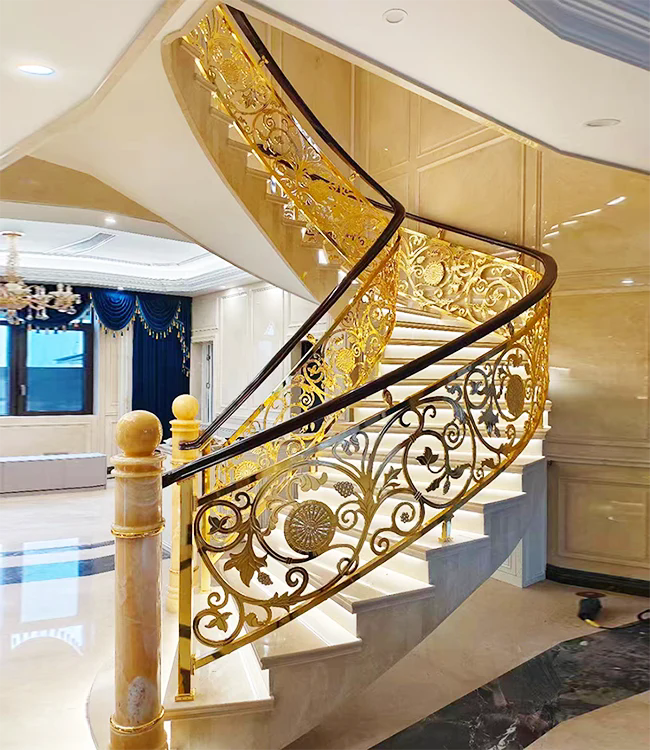Why Are Stainless Steel Stair Handrails Becoming the Preferred Choice for Residential and Commercial Spaces?
2025-11-26
A stainless steel stair handrail is a structural safety component designed to provide support, stability, and architectural enhancement in stairways across homes, offices, factories, and public buildings. The core purpose of this article is to examine what a stainless steel stair handrail is, why it is increasingly adopted worldwide, and how it delivers long-term value in both functional and aesthetic applications.
A stainless steel stair handrail serves three main functions: safety, structural reinforcement, and design integration. As building standards continue to evolve, the demand for durable, corrosion-resistant and low-maintenance materials increases, making stainless steel one of the most reliable choices for modern architecture. At the same time, stainless steel allows flexible shaping, surface treatment options, and customization, which helps designers meet both regulatory requirements and style expectations.
Below is an overview of the typical technical parameters commonly requested in professional engineering and construction projects.
Technical Specifications: What Parameters Should a Stainless Steel Stair Handrail Include?
The following table summarizes key specifications used in architectural and engineering procurement:
| Parameter Category | Specification Range / Description |
|---|---|
| Material Grade | 304 / 316 / 316L stainless steel depending on corrosion-resistance requirements |
| Tube Type | Round, square, rectangular, oval profiles |
| Tube Size (Round) | Ø25.4 mm, Ø38.1 mm, Ø42.4 mm, Ø50.8 mm |
| Tube Size (Square) | 40×40 mm, 50×50 mm, customized sizes |
| Thickness | 0.8 mm – 2.5 mm depending on structural load |
| Finish Options | Mirror polish, satin/brush finish (180#, 240#, 320#, 400#) |
| Mounting Type | Wall-mounted, floor-mounted, glass-mounted, side-mounted |
| Components | Brackets, connectors, elbows, end caps, posts, bases |
| Applicable Areas | Residential stairs, hotels, commercial buildings, industrial walkways, outdoor decks |
| Customization Options | Laser cutting, bending, welding, CNC-machined fittings |
These specifications form the basis of quality evaluation and procurement decisions. A well-engineered stainless steel handrail should combine structural integrity with aesthetic consistency across all components.
What Makes Stainless Steel Stair Handrails a Superior Choice?
To understand the growing demand, several “why” questions help outline the core advantages.
Why is stainless steel considered the most durable handrail material?
Stainless steel contains chromium, which forms a passive protective layer against corrosion. This natural barrier regenerates automatically when damaged, allowing the handrail to withstand moisture, chemicals, and temperature fluctuations. This makes stainless steel ideal for both indoor and outdoor stair systems.
Why do architects and builders prefer stainless steel for safety?
The material possesses a high tensile strength and impact resistance. Even under heavy load or frequent contact, stainless steel maintains its shape without deformation. This reduces safety risks and ensures compliance with building codes.
Why does stainless steel require minimal maintenance?
Unlike wood, which can warp, crack, or decay, or iron, which can rust, stainless steel stays intact with simple cleaning. The long service life significantly reduces replacement and repair costs.
Why does stainless steel offer superior visual versatility?
Stainless steel handrails align with a wide range of architectural styles—from minimalist interiors to industrial and commercial environments. Satin finishes create a soft, modern appearance, while mirror polish adds brightness and elegance to upscale spaces.
Why is stainless steel a cost-effective long-term investment?
While the upfront cost may be higher than traditional materials, the low maintenance requirements and extended durability translate into long-term savings, particularly for commercial buildings with high foot traffic.
How Do Stainless Steel Stair Handrails Function in Real-World Applications?
As construction projects become more complex, “how” questions help clarify performance expectations.
How do stainless steel handrails support structural safety?
The handrails distribute weight evenly and provide a stable grasping surface during movement. When paired with secure mounting hardware, they ensure safety for children, the elderly, and people with mobility needs.
How does the installation process ensure stability?
Installation generally follows these steps:
-
Measurement and layout mapping
-
Mounting bracket and post positioning
-
Anchoring to walls, floors, or glass panels
-
Tube cutting and edge finishing
-
Component connection via welding or mechanical fittings
-
Final surface treatment and inspection
Precision in each step ensures resistance to vibration, impact, and long-term load.
How does stainless steel perform in outdoor environments?
316 and 316L stainless steel grades provide excellent salt-water corrosion resistance, making them suitable for coastal properties, balconies, and public infrastructure exposed to humidity and rain.
How do stainless steel handrails contribute to design integration?
They can be paired with glass balustrades, metal posts, wooden steps, or concrete structures. Curved, spiral, or multi-level staircases can be seamlessly customized using CNC bending and laser cutting.
Industry Outlook: What Future Trends Will Shape Stainless Steel Handrail Development?
Trend 1: Enhanced modular systems
Manufacturers are moving toward modular components that simplify installation and reduce onsite labor. Fit-and-connect systems increase efficiency in large commercial projects.
Trend 2: Sustainability and recyclable materials
Stainless steel is fully recyclable, reducing environmental impact. As green building certification becomes more influential, stainless steel handrails grow in relevance.
Trend 3: Advanced surface treatments
Anti-fingerprint coatings, nano-protective layers, and improved brushing techniques increase durability and maintain cleanliness in high-traffic spaces such as airports and universities.
Trend 4: Design personalization
Demand is rising for customization in shapes, panel combinations, hybrid materials, and color-tinted stainless steel (e.g., black, bronze, champagne) to align with interior design trends.
Trend 5: Integration with smart building technology
Sensor-integrated stair systems, illuminated handrails, and anti-slip technologies may become standard in premium installations.
FAQs: Common Questions About Stainless Steel Stair Handrails
Q1: What grade of stainless steel is best for outdoor stair handrails?
A1: For outdoor use, especially in coastal or humid regions, 316 or 316L stainless steel is recommended because it provides superior resistance against salt corrosion, moisture, and environmental pollution. These grades maintain their strength and color even under long-term exposure to harsh conditions.
Q2: How long does a stainless steel handrail typically last?
A2: A high-quality stainless steel stair handrail can last several decades with minimal maintenance. Its naturally corrosion-resistant properties prevent rust and degradation, while its mechanical strength resists bending and wear. Regular cleaning with mild detergent helps preserve its appearance and protective surface layer.
Conclusion: Why Stainless Steel Stair Handrails Remain a Smart Long-Term Investment
Stainless steel stair handrails combine durability, aesthetic flexibility, and structural reliability, making them an optimal choice for residential, commercial, and industrial applications. Their corrosion resistance, ease of maintenance, and wide range of customization support safety while enhancing architectural value. As global construction standards continue to evolve toward sustainability and long-lasting materials, stainless steel maintains its position as a preferred solution.
Manufacturers such as Nante continue to refine engineering processes, expand customization capabilities, and upgrade surface-treatment technology to meet future market demands. For project consultations, technical specifications, or bulk purchasing inquiries, contact us to receive professional guidance tailored to your building requirements.



